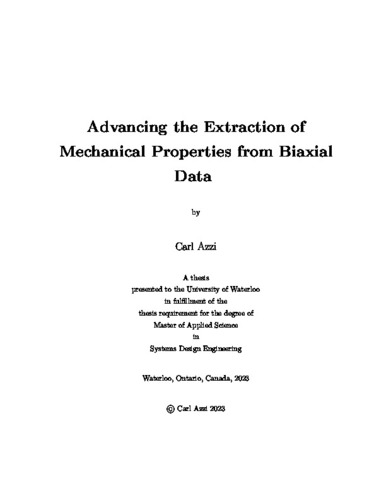| dc.description.abstract | Mechanical characterization is vital to understand soft tissue behaviour in health and pathology. In aortic aneurysms, for instance, it is used to develop techniques for rupture risk assessment. In skin, for instance, it is used to assess the effects of freezing and anatomic location, the information useful for donor tissue banks. Planar biaxial testing is one of the most common tools for the mechanical characterization of soft tissues. In this experiment, loadings such as displacements or forces are applied to the edges of the square specimens yielding deformations at the center of the specimens that are measured digitally. Biaxial testing is a great tool as it captures anisotropy and nonlinearity of soft tissues’ behaviour and is capable of exploring a wide range of deformation states as it can apply different combinations of loadings. However, because the deformations at the center of the specimens are not controlled, no two mechanical tests are equivalent, complicating the consistency in data extraction and comparison.
In this study, we propose a new approach for biaxial data analysis. First, a surface is fitted to the biaxial data. Second, the mechanical response is interpolated at the true equi-biaxial stretch deformation state (the state at which the deformations at the center of the sample are equal). Third, the effective mechanical properties such as high/low elastic moduli, and transition stretches/stress are extracted from the interpolated response. Other studies, in contrast, extract properties at the equi-biaxial displacement deformation state (the state at which equal strains are applied at the sample edges), which is due to the anisotropy of soft tissues and experimental setup, varies from specimen to specimen. We argue that our proposed approach of data extraction is more robust from the mechanical point of view.
To demonstrate that our proposed approach can result in drastically different data sets, we apply it to previously tested aortic tissues from human donors and pigs. We compare effective mechanical properties extracted from the interpolated equi-biaxial stretch deformation state and conventionally used equi-biaxial displacement deformation state. Statistical analysis shows a significant difference between two groups of mechanical measures whether the measures are compared individually within each group or the general comparison of groups is conducted. Particularly, measures related to the transition zones (stress/stretch) linked to collagen fibres’ engagement behaviour were affected the most. Overall, the results indicate that the way the data is extracted can impact the outcome of biaxial studies. This further highlights the advantage of using the proposed approach of biaxial data extraction at equivalent deformation states versus the conventional approach.
The proposed approach of the data extraction was also applied to human skin samples that came from the same donor’s back. Prior to biaxial testing, the samples were frozen/stored using three different freezing protocols (wet freezing in Phosphate Buffered Salin alone and with the cryoprotectant Glycerol as well as dry freezing using Liquid Nitrogen). Then, after testing, the effective mechanical properties were extracted and the effects of freezing and the anatomic locations were evaluated. We found very little quantitive evidence that the freezing storage approach mattered, although some qualitative observations were made to highlight the distinct behaviour of the samples frozen using Liquid Nitrogen. In the case of heterogeneity analysis, samples closer to the spine were different from samples further away from the spine, with the transition zone properties affected the most, especially for the samples subjected to Liquid Nitrogen freezing protocol. Future studies should assess each of the effect of heterogeneity and the effects of freezing separately, however, the overall approach of data extraction seems promising for intra-patient analysis. | en |

